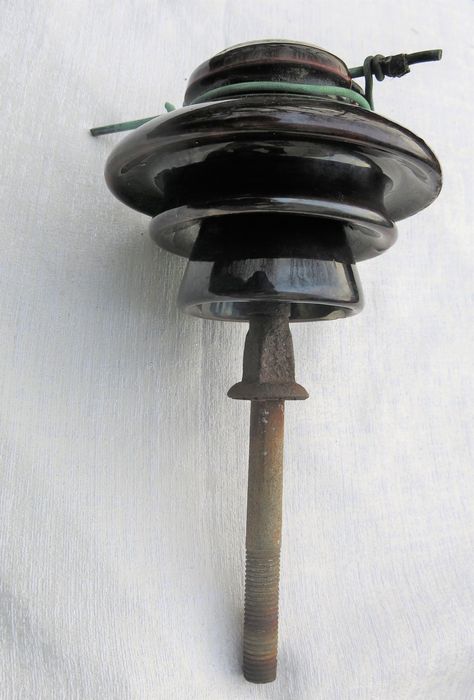
There were a few pioneer transmission lines here in southeast Massachusetts. The several-mile, double-circuit line that went from the Weymouth Light and Power Company generating facility in East Weymouth through Hingham to historic Hull, MA is one of them. This is a recovered Thomas insulator with its original pin and tie wire that came from it (see below). It carried power serving the growing seacoast and tourist community of Hull, Massachusetts. The Hull Municipal Light Plant was formed in 1894 after majority vote by the town's citizens in 1893. Soon thereafter a generating station was erected near the town's geographical center so that its radius of electric lighting lines could reach most customers without significant line loss and voltage fluctuations. The popularity of electric lighting (and appliances commencing in the early 1910s) meant more electrical use, customers and demand. In order to meet this a 13kv double-circuit line was built around 1915 from the East Weymouth generating station to the Hull Light Plant's center of distribution. This supplemented the town's generation operations (it is unknown how long thereafter the town generated their own current). The 13kv private-utility lines owned by Weymouth Light and Power Company complemented the growing demand the Hull municipal required. This pole line employed many Thomas two-piece multipart insulators. Between around 1930 and 1940 the lines were rebuilt by the Weymouth company (part of the New England Power System then) and upgraded to 23kv. K-frame poles using two suspension insulators were employed in wooded areas and cedar poles with Locke 1035 multipart insulators on crossarms along roadways. A fair number of these poles and insulators still remain in service. All of the original insulators from the c.1915 line were discarded during the 23kv upgrade (and that was by 1940). The original conductor was hard-drawn #2 solid copper halfway through its approximately ten-mile length. Most of this was changed to #2 hard-drawn strand copper wire for its entire length during its 23kv conversion (see below). The change in original wire size to #6 from #2 solid took place at the line's mid-point in Hingham, MA soon after it was built (in between Weymouth and Hull) for a tap for the Hingham Municipal Light Plant and to a large water pumping station in Hingham. The municipal utility in the latter town did not have the capacity for this customer, so the private Weymouth utility furnished power to that operation until the mid-1960s when it was transferred to the Hingham Municipal Lighting Plant as a customer. Metering was at the water company station (a couple miles away). When the Weymouth-Hull transmission line was upgraded to 23kv in the 1930s a substation tap to 13kv was added and then ran to the water pumping facility with metering remaining there until Weymouth Light and Power handed it over to the Hingham Light Plant in the 1960s. After then power usage was measured at the Weymouth company's 23 to 13kv substation. [id=650505494] for a view of one of the original transmission line poles. Numerous artifacts in excellent condition were recovered and saved by me during line and station rebuilds during the 1980s and 1990s including old recording watt-hour and demand meters, etc. These now are in my collection. During a 1991 pole changeover in a wooded area a New England Power Service Company employee recovered a couple of the original insulators with their pins and tie wires from c.1915 line. One of the insulators is seen above. For a view of its top: [id=650507043]. Other interesting artifacts pertinent to this line soon will be posted here. For more historical information about the about the Hull Municipal Light Plant: [id=630119681] |